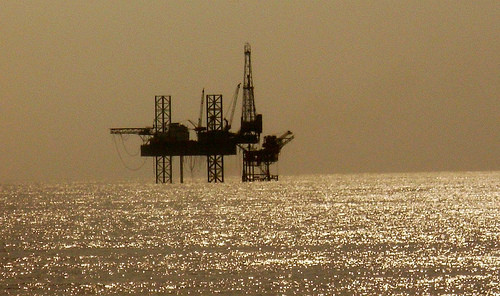Home > Strangulation of oil production

Continued dependence on oil: The world’s daily oil consumption would be 30 billion barrels per year (almost double the oil reserves of Mexico) which represents aa say that every half year, the world reserves phagocytoses an important oil-producing country and alternative energy still need massive subsidies to be viable in developing countries, which together with the hydrogen technology (sort of philosopher’s stone that will solve the energy problems of mankind) is still in its infancy and the inertia of the oil assets will not allow large companies abandon their equipment and existing infrastructure, will make the world economy continues to weigh heavily on oil dependency.
The gas is presented as the only substitute to an alleged shortage of oil, but this action also follows the same path of instability and decline is only a few years after the oil, as some countries have strategic reserves oil intended exclusively for use in critical situations to ensure domestic consumption for a couple of months and others are already timidly taking energy saving measures.
Thus, U.S. President, Barack Obama, announced that the U.S. government will reduce its emissions of greenhouse gases by 28% by 2020 and achieved the target, it would save 250 million barrels by 2020 and China would Five-Year Energy Plan set a goal of reducing dependence on coal and oil in 2010, but according to Greenpeace with a "poor increased renewables 1%), in a country where coal covers 70% of energy needs and if current trends continue, the actual combustion of coal will double in 15 years.
Stagnant oil demand due to the continuing economic crisis through 2012: OPEC estimates that oil demand fell by 1.6% in 2009 due to falling industrial activity that caused the economic crisis and for 2010 overall. considers that the need for oil will increase by 800,000 barrels a day, consuming 85.1 million barrels a day, due to the problems of some eurozone countries such as Greece, the correction of equity markets, rising dollar and concerns about the pace of global economic recovery.
. In any case, recovery and demand will be led by emerging countries like China, as its oil demand has continued to spiral out of reach at present to about 8,200 mb / d (9.72%) compared to 3860 production mb / d, which clearly makes importing about 4340 mb / d. (About 10% of total sales in the market) and by 2010 China will increase its oil demand by 0.4 million b / d (mean number 50% of total world oil consumption growth this year and make China the second largest consumer).

Launching the global decline in oil production: According to the Association for the Study of Oil and Gas (ASPO), the world oil production would have begun its decline, a phenomenon that is explained by means of the analytical methods of the geologist King Hubbert on the production of oil from the United States, a method known as "Hubbert curve." Hubbert calculated in 1956 with extraordinary precision, the date on which the United States could not produce more oil but more wells are drilled, a process of decline continues, causing the United States needed to import more oil each year.
The current oil production comes from more than 60% of mature fields (which have more than 25 years of being exploited intensively) as new surveys are conducted in more remote regions, with higher production costs and lower profitability and threatened on many occasions to parks and reserves and being the gap between world consumption and discovery of new farms abysmal, at a ratio of 4-1.

According to experts, the time required to launch a reservoir at full capacity is about six years, so any discovery can not come into operation until after 2010 and by way of example, new infrastructure projects, oil extraction Crude considered "large" (those of more than 500 million barrels) in Saudi Arabia for 2010 are nonexistent, despite being the largest producer in the world with about 9.5 million barrels a day. Thus, Mexican production will also reach its peak in 2010, because the main reservoir of Mexico is the Cantarell (which generates two-thirds of Mexico’s output) has an expiration date, with consequent effects on the income side of State.
In the case of Russia, and several studies have warned that the end of the first decade of XXI century, this country (which has become even leading producer of oil in times of the year 2007) could enter a situation plateau and then decline because of outdated technologies and the depletion of deposits (in the first quarter of 2009, production fell by 0.3%) and side effects of this production decline in consumer countries will be particularly severe because rigged a constriction of exports even more, so that the EU consumes 30% of Russian oil will get used to Putin’s energy blackmail.
As for Iran, has, according to experts, the third largest proven reserves of oil and gas world, but apparently lacks the technology to extract enough gas in the deeper deposits and the Iranian oil industry requires urgent investment it runs the multibillion-dollar risk of irreversible damage and in accordance with the Fifth Five Year Plan (2010-2015) launched by the regime, the Government is obliged to invest about 155,000 million for the development of oil and gas industry But the nuclear dispute with the U.S. and possible sanctions in the form of external financial starvation may leave this plan obsolete.
Finally, Venezuela sells to the United States 1.5 million barrels of crude for reasons of geographical proximity (the passage of oil tankers to that country last five days, Europe is 14 days and the Far East are 45 days making the rates are prohibitive). However, according to figures from the Energy Information Agency of USA, in October 2009 exports to the U.S. fell 16.6 percent, starting the new Obama Administration policy that conjugaría economic aid and the signing preferential agreements with friendly countries (Mexico, Brazil, Chile and Argentina) with the commercial boycott and isolation in international forums populist regimes-progressive (Venezuela, Nicaragua, Ecuador and Bolivia) to achieve the destabilization of regimes , making the move to Colombia in continental U.S. aircraft carriers.
Possible bottlenecks in the production of oil: The stagnation of oil prices (despite successive cuts in production by OPEC) due to the severe contraction of world demand and the flight of speculative brokers, impossible for countries farmers get competitive prices (hovering around $ 90) that would enable the necessary investment in energy infrastructure and generating new holdings and could draw a bottleneck scenario world oil production, once overcome the current global economic crisis on the horizon 2018.

This presumably will cause psychosis supply shortages and dramatic increases in oil prices that will be reflected in a wild soaring freight transport and agricultural fertilizers, thus coupled with the implementation of restrictions on exports of major world producers to ensure self-sufficiency will eventually cause shortages in global markets, increasing prices to stratospheric levels and the consequent global food crisis affecting especially the Antilles, Mexico, Central America, Colombia, Venezuela, Egypt, India, China, Bangladesh and Southeast Asia, preying particularly virulent and Sub-Saharan Africa and spend the people trapped in the starvation of the current 1,000 million to 2,000 million estimated by analysts.
GORRAIZ GERMÁN LOPEZ




